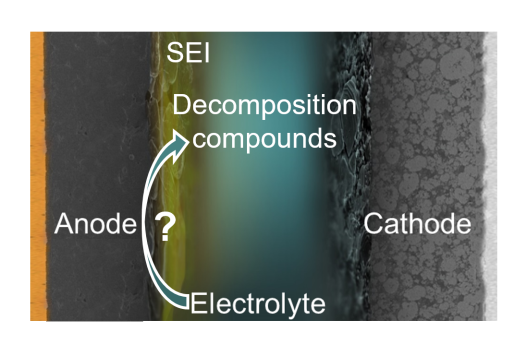Understanding electrolyte decomposition: MEET scientists shed light on this research area
Thanks to the lithium-ion battery (LIB), we can use smartphones, tablets, digital cameras and portable consoles as a matter of course in our everyday lives. But the potential of LIB is far from exhausted. To increase its performance, it is first necessary to understand all processes and reactions in the battery in detail. For this reason, MEET scientists led by Jonas Henschel have taken a closer look at the electrolyte and its decomposition products. Little is known about how the latter are produced and what effect they have on the battery system.
The electrolyte is vital for the current flow in the battery. It decomposes during the first charging process. This so-called cell formation is important because it forms the "solid electrolyte interphase" (SEI), a barrier layer between the surface of the negative electrode and the electrolyte. By preventing direct contact between the two materials, it blocks further decomposition of the electrolyte. At the same time, it is permeable to lithium ions and thus enables charge exchange. The SEI is therefore the key to rechargeable batteries with high capacity and long life. "This makes it all the more important to understand how interphases are formed and composed," stresses MEET PhD student Jonas Henschel.

Why it is essential to understand the decomposition pathways
However, the SEI cannot completely prevent the electrolyte from reacting further. Both electrochemical processes and thermal stress - triggered by high temperatures - can cause additional changes. “In addition to the advantageous formation of an SEI, there are also undesirable decomposition processes. If we know from which components of the electrolyte these products are formed, we can specifically modify them and thus optimize the cell," explains Henschel. By reducing such parasitic reactions, the life, stability and capacity of the lithium-ion battery can be improved without major changes to the existing system. The findings also help to understand the mode of action of promising electrolyte additives.
In order to understand the decomposition pathways of the individual products, the scientists in the study labeled an electrolyte component isotopically. Using mass spectrometry and fragmentation mechanisms, hey then determined the position of the labeled decomposition product in the molecule and drew conclusions about its formation.
Detailed results listed in the study
The authors Jonas Henschel, Christoph Peschel, Sven Klein, Fabian Horsthemke, Prof. Dr. Martin Winter and Dr. Sascha Nowak have published the exact results of how electrolyte decomposition proceeds under thermal and electrochemical load in the journal "Angewandte Chemie". Here you can find the complete study.

